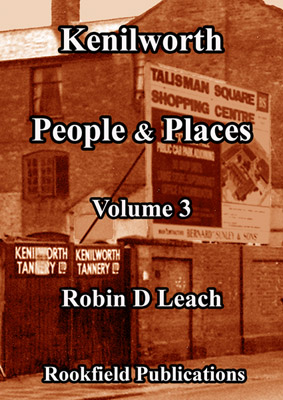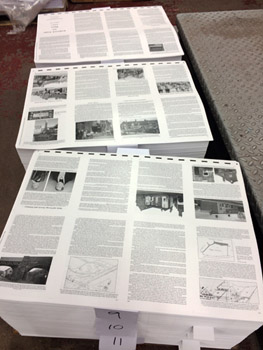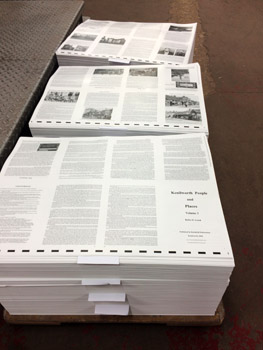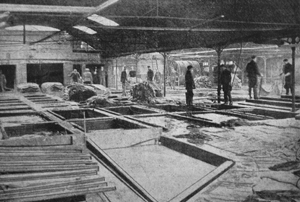Kenilworth People and Places, Volume 3 (2018)

192 pages, over 185 images; RRP £10.95. Now only £8
‘For a relatively small town, Kenilworth has had a complex history; it is indeed fortunate to have a local historian as assiduous as Robin Leach in researching and presenting his findings in print. To comment on, even to list, the manifold subjects covered in this volume would require several pages. The tannery is the majr topic, matched by the fellmongery and later scrapyard site at Mill End. (A four-page free supplement incorporates details of the tannery site from newly available documents.) Shorter items include the suffragettes, a champion cyclist, the Home Guard and pre-fabs. The volume is extremely well illustrated, many illustrations with detailed, informative captions. In short, this is a ‘must have’ book.’
(This review was published in Kenilworth History 2019, the annual publication of the Kenilworth History and Archaeology Society)
 |
 |
Text off the presses, 13th April 2018. (Photo courtesy Tony at Emmerson Press).
The final part of the ‘People and Places’ trilogy concentrates on Kenilworth’s involvement with animal skin processing, and includes the definitive accounts of the fellmongery at Mill End and of the town-centre tannery, with information collected over close on 40 years.
Told in full is the story of the town centre tannery and its onsite associate firm of curriers, J F Ward & Co.
No firm has had the presence in Kenilworth as did the tannery, employing 150 at its peak. Its fortunes often reflected and affected those of the town; in good times the wages paid ended up in the pockets of town traders, when it closed (as it did 4 times) the traders struggled and many homes were short of food. But its employees had a cricket team and benevolent society, and helped to establish and sustain the town’s first Working Men’s Club.
The tannery was started by the Draper family, but Henry Draper was caught up in the failure of a London firm in 1860 and was bankrupted; his saviour was a Leamington bank that unfortunately handled his and the tannery’s affairs poorly, closing the business in 1885, and two years later the bank too went out of business. The tannery was resurrected by Samuel Barrow, who later brought in Charles Randall to manage it, a move that had consequences not just for the tannery but for the town. The curriers of Ward & Co were known to Barrow and Randall in London, and a Kenilworth branch was set up alongside the tannery to supply coloured leather to Coventry’s motor trade. The life-stories of the men involved is also prominent.

The pits of Kenilworth’s tannery, 1908
Included are a number of previously unpublished pre-WW1 photographs of the tannery and curriers at work, the only known such photographs. The story continues with another closure in the mid-1920s, and new proprietors until final closure in 1961, and comes up to date with exclusive photographs of the archaeological dig on the site in February 2018.
The fellmongers works at Mill End was established by Henry Street in 1855, moving from a site in Spring Lane. He had remarkable success and pioneered the importing of skins from around the world. Henry Street’s involvement with local affairs is also explored in full. The business was taken on by his nephew Arthur Street, and later by Arthur’s business partner Arthur Wamsley; it was under Wamsley’s son Harold that the business finally closed during World War 2 after a century of operation. The site’s subsequent story as a scrapyard is also told, and a photographic survey of the site in its final days records the fellmonger buildings. Again, the life-stories of the men involved is prominent; the only known image of Henry Street himself is published for the first time.
Part of the fellmongery can be seen here: https://www.khas.co.uk/the-fellmongery-then-now/
The rest of the book covers a multitude of subjects, with, in most cases, accompanying photographs:
Kenilworth’s Home Guard is featured, as is the post-war building of the prefabs in Stoneleigh Avenue. Continuing a theme of Volume’s 1 & 2, the house-history of the town centre The Yews is told, The Globe Hotel is briefly revisited, and Thickthorn too is revisited with a feature on the now demolished lodge on the Leamington Road.
Individual’s stories are told, such as the Edwardian champion cyclist Alfred Miles, and William Lewis, a charity performer who also took part in a Christmas Day 1915 football match to raise funds for the red cross; Lewis also appears in the oldest known Kenilworth sporting photograph. So too is the surprising story of Robert Podmore, Kenilworth born, who died in his early teens and has a memorial to him – paid for by the Japanese navy.
The life of Walter Lockhart is covered in my early books but is concluded in this, with help from his granddaughter. The extraordinary story of a German family living in Kenilworth at the time of the Great War is told in detail, as is the story of the town’s Edwardian brass bands with which the family were involved.
Other articles include Kenilworth’s involvement with the suffrage movement, the Borrowell Nurseries, the First to last of the Combmakers, and the town’s first Fish & Chip shop. Transport is covered with horse-drawn coaches, traction engines, early buses, and a look at Railway Matters.
Photographic features include; the changing faces of Albion Street and Warwick Road, Cherry Orchard brickworks, the 1936 Carnival’s historic pageant, the Kenilworth Amateur Dramatic Society, and the Robertson family including the only known photograph of their Abbey End house, The Roseary, which was destroyed in the landmine explosion of 1940.
A wide variety of subjects, all told with the author’s well-known eye for detail and clarity of image reproduction.